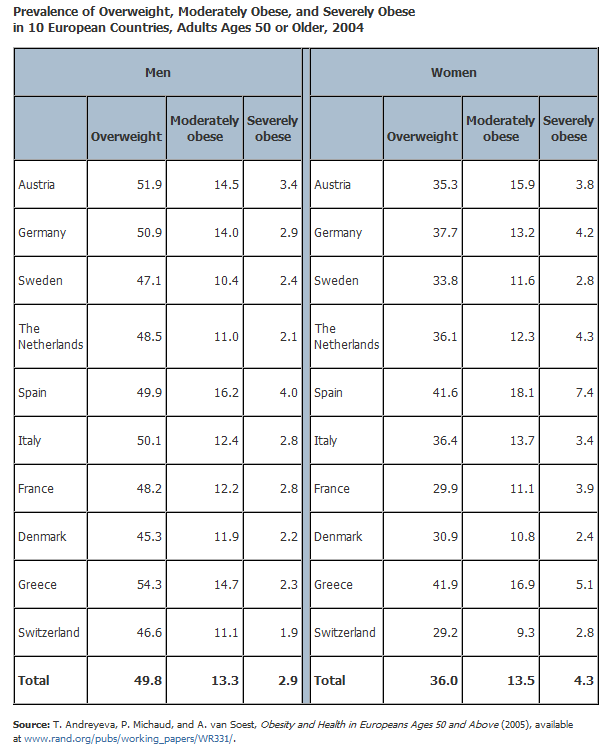
Obesity Threatens the Health of Older Europeans
(June 2008) Obesity is a risk-factor for many preventable, highly prevalent, and potentially fatal chronic health conditions, including cardiovascular disease, diabetes, and some types of cancer. Obese individuals spend about one-third more on health care than similar individuals with normal weight. The extra health care costs from obesity exceed those associated with smoking or problem drinking.1 Rising rates of obesity can explain 27 percent of the growth in real health care spending between 1987 and 2001.2
The growing problem of obesity in Europe was documented in a recent study from the RAND Corporation using data from the 2004 Survey of Health, Ageing, and Retirement in Europe (SHARE). The 2004 SHARE collected information on health, psychological conditions, socioeconomic status, and social support in 10 European countries. The RAND researchers compared the prevalence of obesity and obesity-related health conditions among people in those countries ages 50 and above.3 Older adults were chosen for the comparison because the effects of obesity on health and health care outcomes may not materialize until later in life.
High Rates of Overweight, Obesity
Levels of obesity and overweight 4 were high in the selected countries (see table): In all the countries combined, about 50 percent of men were overweight, 13 percent were obese, and nearly 3 percent were severely obese. Only one-third of men qualified as having normal weight. Among women, 36 percent were overweight, 14 percent were obese, and 4.3 percent were severely obese. Obesity was higher among the less educated: Men and women with primary or no education had the highest rate of moderate and severe obesity (19 percent and 20 percent, respectively). Current smokers had the lowest rate of obesity (14 percent among men; 12 percent among women).

The percentage overweight or obese varied greatly across the 10 countries. Spain had the highest prevalence of moderate and severe obesity among men (20 percent) and women (26 percent). Sweden had the lowest rate of moderately or severely obese men (13 percent) and Switzerland had the lowest rate among women (12 percent). Switzerland, The Netherlands, Denmark, and Sweden had significantly higher rates of normal weight men than the SHARE average. The Nordic countries, Switzerland, and France had higher rates of normal weight women than the SHARE average.
The Link Between Obesity and Health
Overall, this study of elderly in selected European countries found that obesity is strongly associated with major health risk factors, but that there are also cross-national differences in the extent to which obesity is related to depression, heart disease, and high cholesterol levels. Moderate to severe obesity was significantly linked to poor or fair self-reported health, high cholesterol levels, hypertension, arthritis, and heart disease in both men and women. Spain had the highest prevalence of obesity and the highest prevalence of diabetes (about 14 percent among men and women). In Switzerland, the low obesity rate was mirrored in the low prevalence of diabetes (7 percent men, 4 percent women). However, France had relatively low obesity rates, but also the highest rate of doctor-reported high cholesterol levels in men (23 percent) and women (26 percent). Dietary, behavioral, cultural, and genetic differences may be responsible for such variations, as well as for differences in overall obesity rates among the countries.
The RAND team also examined a possible statistical link between obesity and depression. Among men, no association was found between the two. For women, a significant association was found in some countries, but there was no geographic or cultural pattern.
Marc Meisnere is a program associate at the Population Reference Bureau.
For More Information
Tatiana Andreyeva, Pierre-Carl Michaud, and Arthur van Soest, Obesity and Health in Europeans Ages 50 and Above (RAND Working Paper, 2005), available at www.rand.org/pubs/working_papers/WR331/.
References
- Roland Sturm, “The Effects of Obesity, Smoking, and Drinking on Medical Problems and Costs,” Health Affairs 21, no. 2 (2002): 245-54; Eric A. Finkelstein, Ian C. Fiebelkorn, and Guijing Wang, “National Medical Spending Attributable to Overweight and Obesity: How Much, and Who’s Paying?,” Health Affairs, Suppl. Web Exclusive (2003): W3 219-26.
- Kenneth E. Thorpe et al., “The Impact of Obesity on Rising Medical Spending,” Health Affairs, Suppl. Web Exclusive (2004): W4 480-86.
- Austria, Denmark, France, Germany, Greece, Italy, The Netherlands, Spain, Sweden, and Switzerland were included in the study.
- Definitions are based on guidelines for the body mass index (BMI) published by the National Heart, Lung, and Blood Institute of the National Institutes of Health. Overweight = BMI 25.0-29.9; moderate obesity = BMI 30.0-34.9; severe obesity = BMI >=35.
